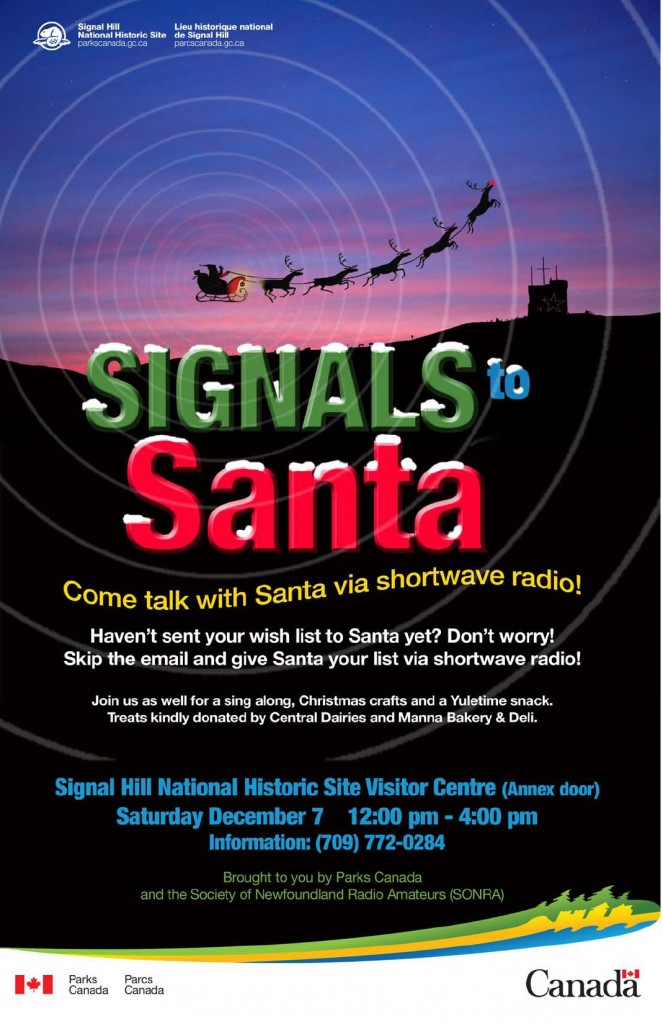If you live in Newfoundland, Canada, you might want to take part in the Signals To Santa event at the Signal Hill National Historic Site Visitor Centre, which is sponsored by Parks Canada and the Newfoundland Radio Amateurs (SONRA).
Many thanks to SWLing Post reader, Tom Ally, for the tip. Tom did some research to find the HF frequency of the event, so it could be monitored. The response from the event coordinators was 146.520 MHz. Not exactly shortwave (ahem, not even by a long shot!).
Still, I love the idea behind the event and think the Parks Canada poster is brilliant!
I believe an amateur radio club organizes a “talk to Santa” type on-the-air event each year. If anyone knows the frequency or details, please comment.


IN the old days, local clubs certainly organized “talk to Santa Claus” nights. Have a
station open to the public, and then someone at the other end pretending to be Santa Claus.
Of course, December is a good month for radio. Marconi spanned the Atlantic in December of 1901, which really was the initial escape of radio from the lab. After that, plenty started playing with it, the beginnings of amateur radio, even before it was a formal service.
But in December of 1921, amateur radio operators spanned the Atlantic again, this time at actual shortwave frequencies. As rules became stronger, and the value of radio proved, hams got squeezed out, at a time when people thought the only valuable frequencies were those up to about the top of the current AM broadcast band, around 1700KHz. Which didn’t leave much space for military and ships at sea and broadcasting. So hams got relegated to the “useless” frequencies below 200 metres after WWI, nobody wanted them. Though, technically hams got all that space.
Initially long distance communication had been done by relay, which is why the American Radio Relay League has such a name. But some work at the higher frequencies suggested they could be used for distant communication, and eventually there was some cross-Atlantic testing in 1920, without absolute results. In 1921, the ARRL sent Paul Godley over to England to set up an official receiving station. And then in December of 1921, he listened while hams in the US transmitted, and he heard them.
That showed the value of shortwave, and soon the spectrum was carved up further, the ham bands being small segments through the spectrum.
In essence, ham radio exists because it was there from the beginning. All the other services came with time, as people figured out what to do with this new thing radio.
And of course, in December fo 1961, OSCAR 1 went up. An amateur radio satellite built in a garage, it lasted for a few weeks, transmitting the same morse code “hi”, the speed varied by something, either battery voltage or temperature, a rudimentary telemetry. The first non-government, non-commercial satellite into space, it also proved the value of using a rocket to launch multiple satellites, when before that, it was one satellite per rocket. Such a change, its now really hard to find space on a rocket at cheap rates.
Michael
Brilliant comment, Michael. Thanks for the insight and history.
-Thomas
http://pbcskywarn.angelfire.com/santa12.htm
The Maritime Mobile Service Network 20m Santa Claus Net. Dec 23 & 24th 1900 UTC to 01000 UTC each day Frequency Range: 20 meter -14.305 – 14.320 Check with the Maritime Mobile Service Net on 14300 MHz for the actual Santa clause operating frequency. “
Many thanks, WA4CZD!!!
-Thomas